|
Pennsylvania Furniture
A Unique Style All Its Own
by
Bob Brooke
The Pennsylvania style of
furniture, also referred to as “stone farmhouse” furniture, began in
Chester County, Pennsylvania, just west of Philadelphia. Here Quaker
farmers, who had emigrated from England as part of William Penn’s great
plan, settled amid the rolling hills.
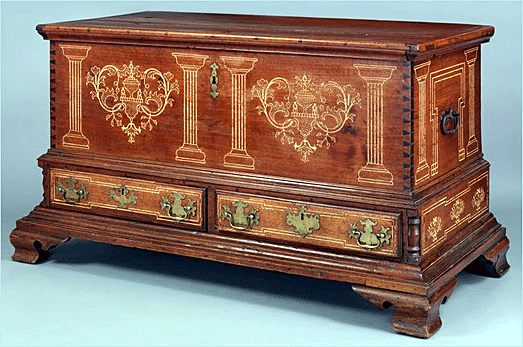
During the mid-18th to early 19th centuries, Chester County,
Pennsylvania, became one of the prime manufacturing centers of this
type of furniture. Originally, Chester County and present-day
Delaware County were then known as Olde Chester County. But the true
Golden Age of the Pennsylvania style flourished around the time of
the adoption of the U.S. Constitution. Since the area around the
delta of the Delaware River is also known locally as the Delaware
Valley, many of these pieces are also called Delaware Valley
furniture.
The Origins of Pennsylvania
Furniture
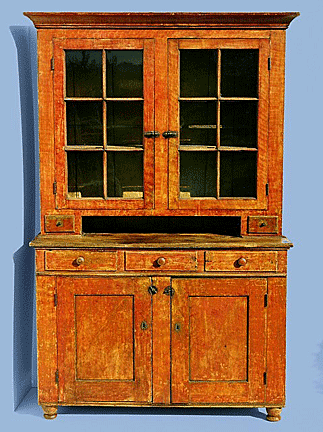 The
conservative nature of Pennsylvania Quaker life tended to preserve
Old-World taste and traditions, especially in rural areas, long
after the popularity of a form had died out abroad or in more
fashion-conscious Philadelphia. Unlike those pieces made in urban
areas, Pennsylvania rural furniture displayed sturdy skills of the
joiner and turner, especially those of the Welsh, who immigrated to
southeastern Pennsylvania in the 1680s. But they also featured
classical pediments and curving bracket feet more associated with
Philadelphia cabinetmakers. The
conservative nature of Pennsylvania Quaker life tended to preserve
Old-World taste and traditions, especially in rural areas, long
after the popularity of a form had died out abroad or in more
fashion-conscious Philadelphia. Unlike those pieces made in urban
areas, Pennsylvania rural furniture displayed sturdy skills of the
joiner and turner, especially those of the Welsh, who immigrated to
southeastern Pennsylvania in the 1680s. But they also featured
classical pediments and curving bracket feet more associated with
Philadelphia cabinetmakers.
Non-Germanic settlers in the Delaware Valley maintained woodworking
traditions of framing and turning similar to those of the English
Quakers. The Welsh, for instance, brought designs using inlay with
them. They often inlaid initials and dates on the front of a piece
of a cabinet or chest. Back then, It was the custom to have a
handsome piece of furniture made for a special occasion such as a
wedding or anniversary. Prosperous husbands often gave a special
piece to their wives.
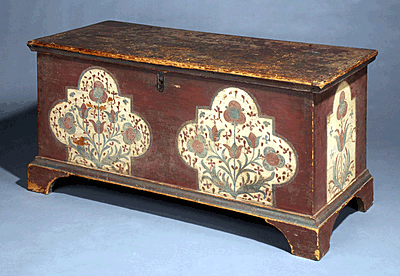 Pennsylvania
Germans living in central Pennsylvania were partial to graining.
They referred to pieces made between 1825 and 1850 and painted to
look like wood, as common furniture. They employed this same
decorative technique to the surfaces of doors and woodwork in their
homes. Pennsylvania
Germans living in central Pennsylvania were partial to graining.
They referred to pieces made between 1825 and 1850 and painted to
look like wood, as common furniture. They employed this same
decorative technique to the surfaces of doors and woodwork in their
homes.
The Chippendale style of Philadelphia formed a basis for fine
pieces, and the William and Mary style of England remained popular
due to the traditions of the Quakers. There was an overlapping of
styles including imported pieces and those made locally by skilled
craftsmen from native woods, especially black walnut. Southeastern
Pennsylvania cabinetmakers also adapted the newer English furniture
designs, though they tempered them with their conservative Quaker
taste for simplicity. Such a melding of city and rural-made
furniture came as a result of William Penn’s plan of religious
tolerance and co-existence for his colony.
The result was a healthy interaction in the decorative arts. Added
to the Welsh-Irish influences was distinctly German-Swiss stylistic
element emanating from Germantown, as well as the towns of Lancaster
and Reading.
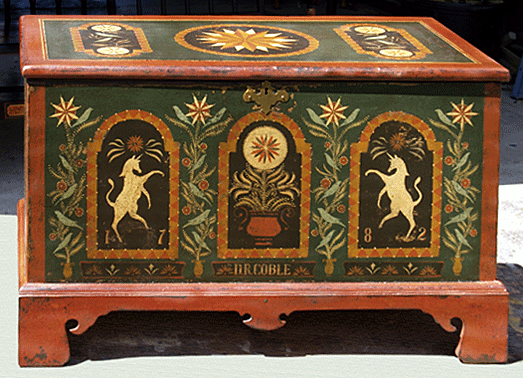
But the tradition-bound rural folk kept to old forms and weren’t
quick to adopt the furnishing changes coming out of Philadelphia.
Urban cabinetmakers quickly adopted the flowing Queen Anne style in
the 1730s, then the height of fashion in England. Chairs
specifically took on rounded crest rails, urn-shaped splats and
out-swept arms. The yoked crest rail joines the stiles, which
continue down to form the square back legs on chairs. Vase and block
turned front legs were connected by a double baluster-ring-and -reel
turned front stretcher ending in elongated ball feet. Eventually,
the Queen Anne form evolved into the highly ornate Chippendale style
of the 1750s.
The Spice Cabinet
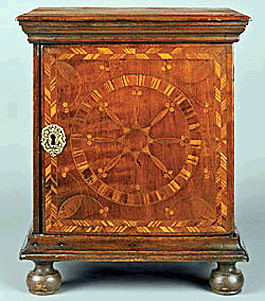 The
18th-century spice cabinet is the ultimate form of Pennsylvania
furniture. The concept, originally from Holland, came to America
from England. The spice cabinet flourished in Chester Chester
County. Only the most prosperous families could afford these
miniature case pieces which housed expensive spices for medicine and
cooking, as well as small valuables. Many had a series of small
drawers hidden behind a door and a secret drawer behind them or a
drawer hidden beneath the molding. People didn’t place their spice
cabinets in their kitchens, as they do today, but rather, in their
parlors where they would harmonize with other furnishings. The
18th-century spice cabinet is the ultimate form of Pennsylvania
furniture. The concept, originally from Holland, came to America
from England. The spice cabinet flourished in Chester Chester
County. Only the most prosperous families could afford these
miniature case pieces which housed expensive spices for medicine and
cooking, as well as small valuables. Many had a series of small
drawers hidden behind a door and a secret drawer behind them or a
drawer hidden beneath the molding. People didn’t place their spice
cabinets in their kitchens, as they do today, but rather, in their
parlors where they would harmonize with other furnishings.
Seating
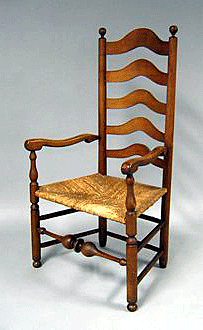 Chairs were an important feature of any room. The Delaware Valley
slat-back chair, made from 1720 to 1830, had three to six graduated
slats that might be arched only on top, arched on the top and
bottom, or more rarely, scrolled. Back posts were plain and tapered
from the seat to the finials. Back feet tapered sharply to the
floor. Front feet were almost always ball shaped and wider than the
front posts. Finials were acorn-shaped. Chairs were an important feature of any room. The Delaware Valley
slat-back chair, made from 1720 to 1830, had three to six graduated
slats that might be arched only on top, arched on the top and
bottom, or more rarely, scrolled. Back posts were plain and tapered
from the seat to the finials. Back feet tapered sharply to the
floor. Front feet were almost always ball shaped and wider than the
front posts. Finials were acorn-shaped.
The Chester County joined chair, also known as a wainscot chair, was
popular from 1710 to 1740. Joiners constructed many in the
200-year-old William and Mary style with back slats and a solid
seat, made for use with a soft cushion. These chairs had turned
front legs and stretchers while back ones were plain.
Joiners made these chairs without carving, reflecting the Quaker
philosophy of simplicity. While English chairs were made of oak,
their Pennsylvania counterparts were made of walnut. These chairs
featured a pierced and scrolled crest rail, a motif found in England
along the Welsh border. The negative spaces in the Chester County
chair crest rail formed a pair of sixes.
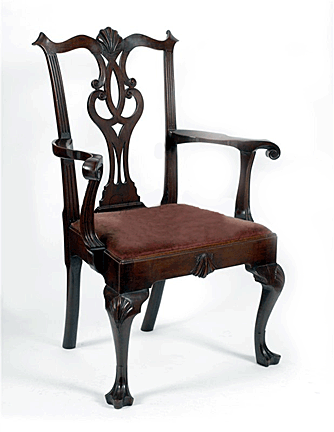 Armchairs, also known as great chairs, had baluster turnings below
the arms, and, on the better ones, ball-and-reel turnings just below
the front seat. The arms almost always had a cut out on their
undersides, a feature found on many Chester County
rush-and-splint-seat armchairs. Also typical was a single, and
rarely a double, baluster-ring-and-reel turned front stretcher.
Posts became thinner, finials more vertical, slats fewer in number
and front stretchers less boldly turned. Armchairs, also known as great chairs, had baluster turnings below
the arms, and, on the better ones, ball-and-reel turnings just below
the front seat. The arms almost always had a cut out on their
undersides, a feature found on many Chester County
rush-and-splint-seat armchairs. Also typical was a single, and
rarely a double, baluster-ring-and-reel turned front stretcher.
Posts became thinner, finials more vertical, slats fewer in number
and front stretchers less boldly turned.
Benches were popular in rural households. Generally, joiners made
them with legs formed from single boards with cutouts for feet. They
connected the legs connected to each other with a stretcher or skirt
and braced them into a plank seat. Often, Pennsylvania benches had
scrolled legs, and sometimes makers left the rear legs flat so that
the bench could be used against a wall.
In addition to chairs and benches, many colonial homes had settles
which evolved from built-in furniture of the late Middle Ages. A
tall back protected the sitter from cold and drafts, especially when
placed near a fireplace to retain the heat. Homeowners also used
settles to subdivide a room or, placed at a right angle to the front
door, to create an entry way.
Another popular piece was the settee. Those made in rural
Pennsylvania had what’s called a half-spindle back, a
Windsor-derived style. Large scrolled arms swooped up to meet the
crest rail, a typical Pennsylvania feature.
Tables
Next to chairs, tables were the most numerous of household furniture
made in the 18th century. Some people called three-legged tables of
this type tavern tables, although they could be found as much in
homes as in taverns.
Three splayed legs and simple column-top turnings support the top of
this round table, consisting of two planks pinned to a center board
and triangular skirt boards. The base stretchers formed a triangle
which repeated the shape of the skirt. This type of table would have
been extremely functional in the home because it was strongly
constructed, easily portable, and its three legs would keep it
steady on an uneven floor.
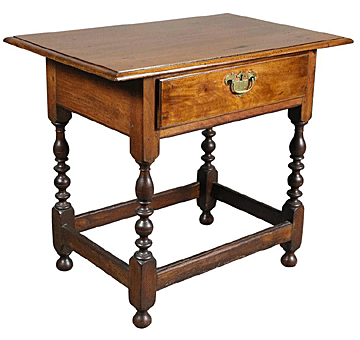 Another variation on this type of table was the rectangular style
with a large overhang and two drawers. The detachable top allowed
the table to be placed out of the way against a wall. The
significant overhang permitted working, writing, or eating. Another variation on this type of table was the rectangular style
with a large overhang and two drawers. The detachable top allowed
the table to be placed out of the way against a wall. The
significant overhang permitted working, writing, or eating.
Although tavern tables could be found throughout the Colonies, those
in Pennsylvania had removable tops and drawers of different widths.
Typically these were relatively small tables, often with walnut,
maple or cherry bases, with up to two drawers, a rectangular pine
top and turned legs connected by turned medial stretchers. One of
the most common turnings used for legs was what was known as a cup
and vase—what looks like a cup with a vase on top of it. Another
variation was the vase and cylinder.
A library table was essentially a larger version of a tavern table.
In Pennsylvania style, the drawers were of unequal widths and a flat
stretcher connected the legs. Trifid feet were also added, as well
as removable tops.
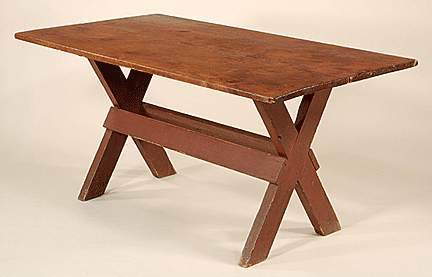 Sawbuck tables had a rectangular top that rested on, or was attached
to, X-shaped legs connected by a long stretcher. Where the legs
crossed there was a lap joint plus an open mortise through which the
stretcher fitted and was wedged with a key. Early versions were made
to be dismantled for storage. Those made in the Delaware Valley
during the 18th century had tops attached to the base with cleats.
The legs were often scrolled as well, mimicking European designs.
Early tables had hardwood bases and pine tops. Later ones all pine. Sawbuck tables had a rectangular top that rested on, or was attached
to, X-shaped legs connected by a long stretcher. Where the legs
crossed there was a lap joint plus an open mortise through which the
stretcher fitted and was wedged with a key. Early versions were made
to be dismantled for storage. Those made in the Delaware Valley
during the 18th century had tops attached to the base with cleats.
The legs were often scrolled as well, mimicking European designs.
Early tables had hardwood bases and pine tops. Later ones all pine.
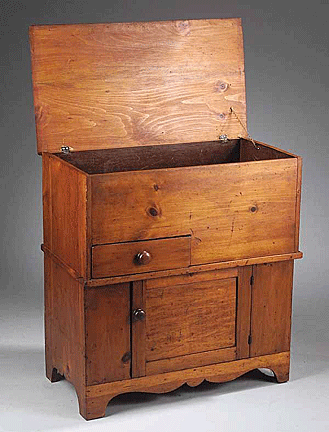 The hutch table, essentially the same as a chair table, had a seat,
hinged to open for storage, that was wide enough for two or more
people. People often referred to it as a bench or settle table. In
Pennsylvania during the early 19th century, the underside ends of
the hutch top were paneled. The hutch table, essentially the same as a chair table, had a seat,
hinged to open for storage, that was wide enough for two or more
people. People often referred to it as a bench or settle table. In
Pennsylvania during the early 19th century, the underside ends of
the hutch top were paneled.
The primary function of the dough box table was to serve as a trough
to store rising bread dough. Made primarily in Pennsylvania from
1700 to 1840, it had a single or multiple-board top with cleats at
each end that often slid into dovetail slots. The top, used as a
work surface to knead the dough, rested on a trough that ordinarily
had splayed, dovetailed sides. This, in turn, rested on or was
attached to a tablelike frame that usually had splayed legs. Many
were paint decorated.
Chests
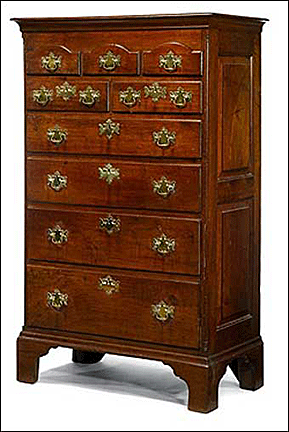 The
chest of drawers, an innovation from the Continent, developed from
the one-drawer chest with a lid. It replaced the blanket chests and
press cupboards and served as a storage area for clothes, blankets
and linens. The
chest of drawers, an innovation from the Continent, developed from
the one-drawer chest with a lid. It replaced the blanket chests and
press cupboards and served as a storage area for clothes, blankets
and linens.
Vine-and-berry inlay, brought to Chester County by Welsh settlers,
decorated drawer fronts. Frequently, cabinetmakers used an
elongated, symmetrical diamond-tulip pattern. They created the
diamond in the center by the intersection of four arcs, from which
grew vines, with a cluster of three small berries and lively
stylized tulips. To emphasize the border of each drawer, they
employed a straight-line inlay which enclosed the decorative motif
and defined the rectangular space. Chests had raised panels which
went to the floor on the ends. Cabinetmakers added the curved part
of the leg later.
Another feature of the Pennsylvania style were arched chest drawer
fronts. Besides the vine-and-berry inlay designs, herringbone
patterns were also popular.
Pennsylvania cabinetmakers like Thomas Gilpin and Abraham
Darlington, both Quaker craftsmen, were fond of adding lots of
panels to their chests, reminiscent of the William and Mary style.
Simple four-drawer painted pine and poplar chests appeared later in
the 19th century and often featured dentil molding around the top.
Exposed dovetails were common. All in all, Pennsylvania chests were
plain in form, but festive in decoration.
Storage Pieces
While
cabinetmakers made open cupboards in all parts of the Colonies,
those made in Pennsylvania were often of Welsh design with knoblike
scrolled continuation of the sides and spoon slots in one or more of
the shelves.
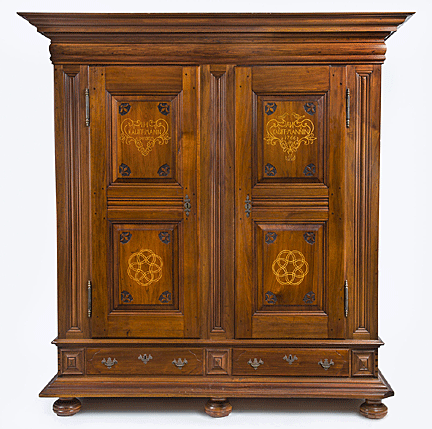 The same was true of corner cupboards. They constructed the top and
bottom sections in two parts to make them easy to move—the bottom a
closed cupboard and the top an open one. Those from Pennsylvania had
unequal width drawers in the bottom section and large knobs, as well
as ball feet. The same was true of corner cupboards. They constructed the top and
bottom sections in two parts to make them easy to move—the bottom a
closed cupboard and the top an open one. Those from Pennsylvania had
unequal width drawers in the bottom section and large knobs, as well
as ball feet.
Another necessary storage unit was the kas—from the German
casten, meaning cupboard, or schrank, as it was known in
German. These large wardrobes, made from 1700 to 1840, had a large
upper section with or without shelves over one to three drawers.
Although some kases were smaller, many of them were elephantine. It
wasn’t unusual for a Pennsylvania kas to be 7 to 8 feet tall, 7 ½
wide, and 25 to 30 inches deep. Cabinetmakers outfitted these larger
kases with removable pins and wedges so that they could be
completely taken apart for transportation or to fit through
doorways. Popular wood for construction included walnut, red gum,
popular, or pine.
An unique piece of furniture, popular from 1800 to 1840, was the
bucket, or water bench, often referred to as the dry sink. This
featured a closed cupboard below a single raised shelf with a
gallery around it. But simple pieces with an open lower cupboard and
no backboards were also made. Pennsylvania bucket benches were often
5 feet tall and fairly elaborate, with scrolled sides and feet and a
tier of small drawers below the top shelf. The top shelf held
kitchen utensils, buckets of water on the shelf above the cupboard
and empty buckets in the cupboard. While some joiners made these,
farmers made most of them from soft woods like pine.
Candlestands
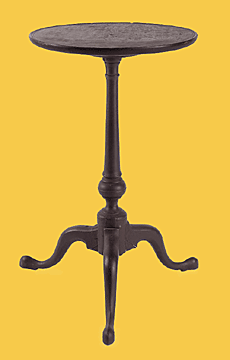 An unusual and interesting variation on the traditional colonial
candlestand was the rachet candlestand made in southeastern
Pennsylvania from 1710-1740. This candlestand, with trestle base and
ratchet mechanism, superbly performed its intended function of
raising and lowering a support for a candle. All parts were
interestingly divided and balanced, making it an abstract work of
art as well. A heavy base assured stability. Though often made of
pine, people in both town and country homes used them. An unusual and interesting variation on the traditional colonial
candlestand was the rachet candlestand made in southeastern
Pennsylvania from 1710-1740. This candlestand, with trestle base and
ratchet mechanism, superbly performed its intended function of
raising and lowering a support for a candle. All parts were
interestingly divided and balanced, making it an abstract work of
art as well. A heavy base assured stability. Though often made of
pine, people in both town and country homes used them.
While Pennsylvania furniture is unique in some of its style
attributes, it’s similar to other furniture of the colonial period
when it comes to buying and selling it. Supplies tend to be low and
prices high.
Desks
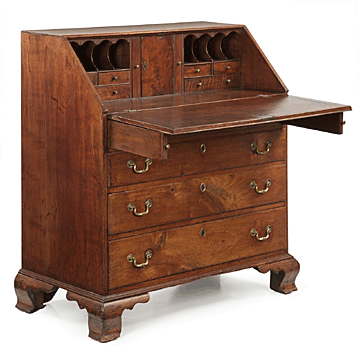 Desks began as writing boxes with sloping lids which people placed
on a stool or table. Eventually, cabinetmakers hinged the lid on the
bottom so that when opened, it acted as a writing surface. Desks began as writing boxes with sloping lids which people placed
on a stool or table. Eventually, cabinetmakers hinged the lid on the
bottom so that when opened, it acted as a writing surface.
While the center of style during the late 18th century was
Philadelphia, cabinetmakers all over the region added their own
ideas to traditional bookcases and desks. Many worked in walnut, a
plentiful hard wood and a reasonable substitute for mahogany. They
picked their woods in such a way as to show maximum effect of the
grain on the bookcase doors and drawer fronts. Unlike those made in
sophisticated Philadelphia, the regional ones had plainer features.
Rural cabinetmakers commonly used shell and pillar motifs on the
interiors of the desk portions.
<
Back to Antiques Archives
Next Article > |
